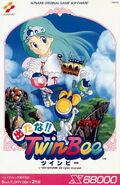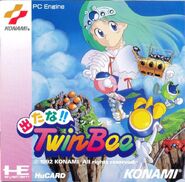Detana!! TwinBee (出たな!! ツインビー, lit. "Here Comes!! TwinBee"), originally released outside of Japan as Bells & Whistles, is a vertical-scrolling shoot-'em-up game originally released by Konami in 1991 as a coin-operated video game. It is the fifth game in the TwinBee series and the second released for the arcades following the original TwinBee (the previous sequels were released directly to home consoles).
Detana!! TwinBee marked the debut of Japanese animator Shujirō Hamakawa (credited under the pen name SHUZILOW.HA) as the series' primary character designer for every following installment. Detana!! TwinBee was awarded "Best Shooting Game of 1991" by the Japanese arcade game magazine Gamest.
Plot[]
Set several years after the events of the original game, TwinBee (Light) and WinBee (Pastel) are relaxing at their island when they receive an SOS signal from the distant Planet Mel. The signal contains a message sent by Princess Melora, who pleads for the salvation of her planet from the invading forces of the evil alien Iva. TwinBee and his friends decide to set off to outer space to defeat the forces of Iva and save Planet Mel.
Detana!! marks the first appearance of TwinBee's and WinBee's respective pilots, Light and Pastel, who became prominent characters in many subsequent TwinBee video games.
Gameplay[]
Aside from the improved graphics and sounds compared to previous TwinBee installments, the gameplay in Detana!! TwinBee follows the same conventions established in the arcade version of the original TwinBee. As usual, the game can be played by up to two players, with Player 1 piloting TwinBee, while Player 2 pilots WinBee. Controls consist of an eight-way joystick for moving the ship and two buttons. In the Japanese version, one button is used to fire the gun at airborne enemies while the other is used to drop bombs to the ground. In the international arcade release, Bells & Whistles, both buttons are used to shoot and drop bombs at the same time. This time, holding down the shooting button will cause a power meter at the bottom of the screen to fill up, allowing the player to fire a "Big Shot" attack when releasing the button.
The power-ups consist of bells which can be uncovered by shooting floating clouds in the playfield, as well as items uncovered by destroying land enemies. Like in the original TwinBee, the player can shoot the floating bells to change their colors. In addition to the five different colors from the original TwinBee (yellow, white, blue, green and red), there are also two new additional bells: a purple bell that provides a "tail shield" that activates multiple barriers around the player's ship, and black bell which decreases the player's speed. The mini-bell and the lucky star from the original TwinBee return as well.
 - Gives the player bonus points. More points added if collected without missing one (500, 1,000, 2,500, 5,000 and 10,000 points).
- Gives the player bonus points. More points added if collected without missing one (500, 1,000, 2,500, 5,000 and 10,000 points). - Upgrades the player's gun into a double shot.
- Upgrades the player's gun into a double shot. - Increases the ship's speed by one level.
- Increases the ship's speed by one level. - Gives the player's ship a mirror image for added firepower.
- Gives the player's ship a mirror image for added firepower. - Surrounds the player's ship with a barrier for extra protection from enemy fire.
- Surrounds the player's ship with a barrier for extra protection from enemy fire. - Generates three Tail Shields that trace you; these destroy aerial enemies or enemy bullets upon contact.
- Generates three Tail Shields that trace you; these destroy aerial enemies or enemy bullets upon contact. - Decreases the ship's speed by one level.
- Decreases the ship's speed by one level.
GwinBee, a ship similar to TwinBee and WinBee, also appears in the game, allowing the player to combine their ship with it in order to fire wider fire beams. Two players can also align their ships side-by-side to achieve the same effect or align their ships vertically for a powerful five-way spread. If both players align their ships with GwinBee between them, he will spring out and destroy all enemies onscreen.
The game consists of seven stages. After the game is completed once, the player can play the game again for a harder second round. The game ends entirely after the second round is cleared. After a game over, the player can continue and receive a "free" power-up.
Ports[]
In Japan, Detana!! TwinBee was ported to the X68000 computer in 1991 and to the PC Engine in 1992. The arcade version was ported as well for the PlayStation and Sega Saturn in the compilation Detana TwinBee Yahho! DELUXE PACK and for the PlayStation Portable in TwinBee Portable. Detana!! TwinBee for the mobile phones on July 14, 2004 in Japanese Markets. The PC Engine port of the game was released for the Wii Virtual Console in North America and Europe in 2009 as a "Hanabi Festival" release. The game was released for the PlayStation Network in Japan on June 16, 2010. On November 24, 2010, the game was released on Xbox 360 and PC; included as part of the "Game Pack 012" of the Game Room gaming service. The PC Engine version was released on March 3, 2014 in Japan on PC as part of the Project EGG. The arcade version was also included in January 2020 as part of the Arcade Archives on PlayStation 4 and Nintendo Switch.
Characters[]
| Images | Name | Information |
|---|---|---|
| TwinBee | ||
| WinBee | ||
| GwinBee | ||
| Light | ||
| Pastel | ||
| Princess Melora | ||
| Iva |
Stages[]
| Stage | Boss | Background music |
|---|---|---|
| Stage 1: Valley of the Wind | Mecha-Crab | Gift of the Wind |
| Stage 2: Sea of Clouds | Flying Ghost Ship | Crossing the Sea of Clouds |
| Stage 3: Fortress in the Sky | Windmill Guy | Sky Fortress Laputa |
| Stage 4: Death Valley | Mekakurage | World of the Mold |
| Stage 5: Groundwater Fountain | Red Mechanical Worm | Aquatic March / March of the Water |
| Stage 6: Iva's Temple | Precious Metal | Iva's Temple |
| Stage 7: Underground City | Iva | Paradise Beyond the Fog |
Related products[]
- Detana!! TwinBee (soundtrack)
- Detana!! TwinBee (manga)
- Konami Video Collection
- King CGV Series - A 1992 VHS strategy guide video by King Video featuring this game.
- Konami Ending Collection
- WinBee's Neo Cinema Club ~Evergreen~
- Game Sound Legend Arrange Series: Speed & Wind
- Detana TwinBee Yahho! DELUXE PACK - Additional voices were added to the ending scene in the PlayStation and Saturn ports of this game.
- TwinBee Portable - Compilation containing the arcade version of Detana!! TwinBee.
Gallery[]
Packaging artwork[]
Promotional artwork[]
Trivia[]
- After the end credits, the staff put a special dedication message to Masato Ohsawa, the director and creator of the game, who passed away on January 2, 1991, just seven weeks prior to the original arcade release of the game.




